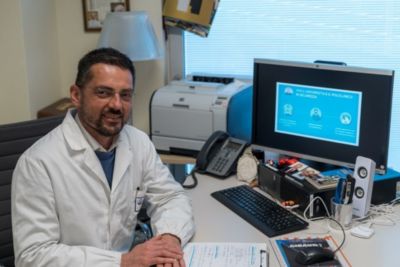
Prof. Dr. Carlo Cosimo Quattrocchi
Former Head of Diagnostic Imaging and Interventional Radiology, Campus Bio-Medico University, Rome, Italy
Campus Bio-Medico University Hospital uses a Philips solution to make all relevant patient information and studies available in one view so that the right radiologist at the right time has the right study for streamlined workflow, as well as improved patient outcomes. A single workspace indexes multiple archives stored on disparate servers. This workspace allows for the delivery of the most urgent studies to the most qualified radiologists, expediting reading and reporting. The solution offers significant benefits that improve IT and radiology effectiveness and satisfaction.

Prof. Dr. Carlo Cosimo Quattrocchi
Former Head of Diagnostic Imaging and Interventional Radiology, Campus Bio-Medico University, Rome, Italy
In complex radiology facilities, where there is an ongoing stream of imaging cases – some urgent, some less urgent and some highly specialized – it can be a challenge to manage the prioritization and delegation of cases to the radiologist best suited to read a particular exam, whether because of expertise or prior history.
The workflow of Campus Bio-Medico University Hospital needs to provide coverage every day, while ensuring that the specialist skills are always available. Streamlining workflow is imperative not only to deliver a high level of patient care, but also to address the very real challenge of radiologist burnout. Dr. Carlo Cosimo Quattrocchi, Head of Diagnostic Imaging and Interventional Radiology, says, “All skills must always be covered. It is not enough to manage the radiological work in terms of time and competence. Therefore, a tool was needed that could direct examinations to radiologists who had the closest skills to give the best answers to the question – in terms of time and competence.”
The workflow orchestrator allocates the exam to a specific person with the best profile, credentials and specific skills to manage that exam…This alone already speeds up the workflow by 50%.

A key part of the collaborative solution installed at Campus Bio-Medico is the Philips Radiology Workflow Orchestrator smart workflow management system that is designed to automatically determine the best match to help deliver the right case to the right radiologist, based on their area of expertise, availability and current workload.
The optimized allocation of radiologist time and skills not only enhances productivity, but it also increases radiologist satisfaction, which is a vital benefit at a time of worldwide radiologist shortages.
Dr. Quattrocchi says, “A radiologist is not only an ‘interpreter’ of images but a consultant for clinical activity. The solution increases radiologist satisfaction by allowing them to focus on their strengths.”
The radiology workflow orchestrator categorizes urgent patients in the worklist. This enabled the hospital to deliver an improved response to the COVID-19 pandemic by managing work shifts and workforce resources.
“The workflow orchestrator made it possible for us to use specific skills of all radiologists in the ward, not just the ones on duty. In terms of allocated resource, this allowed us to reduce the impact of the emergency room workflow on our normal workflow,” says Dr. Quattrocchi.
The implemented solution makes it possible for clinicians to focus on their images, rather than managing the worklist. The level of satisfaction is very high. Radiologists often wonder how they did that before the implementation of workflow orchestrator.

Communication capabilities are enhanced to allow online chat as well as enabling context and screen-sharing to drive diagnostic concordance so that a radiologist reading the exam can connect to another specialist using native chat and screen-sharing to discuss the case in a secure digital environment, giving the patient the best chance of timely diagnosis and effective treatment.
Dr. Quattrocchi says, “Before having the solution, in order to ask for a second opinion, the radiologist used to have to move from one location to another. They’d then have to reach a colleague, interrupting the colleague’s work as well as their own. Now all of this can be done via chat. With chat, we can screen-share the images being reported at that precise moment without having to interrupt the reciprocal workflow. This function makes it possible to consult with a colleague and arrive at an answer even earlier.”
Quality and efficiency of reporting is key to the hospital. To avoid manual importing of relevant findings and to have faster turnaround on exams delivering greater clinical value, native interactive reporting was introduced in the workspace. Interactive multimedia eliminates the need for a separate reporting solution. It enables the radiologist to automate the insertion of image-related information into the report and in return, the referring physician receives a clearer, tracked and more insightful report with the ability to make simple volumetric comparisons and bookmarking tools that allow for marking up, retrieval, viewing and follow-up over time. Marco Venditti, Head of IT Operations for Campus Bio-Medico, says, “By using the workflow orchestrator to report images closest to them, we can also guarantee optimal reporting quality. Calls to public relations office have been drastically reduced and this really does result in a better outcome for the patient.”
The organization estimates that after implementation of the solution there was reduction in the standard deviation among radiologists from 3.5 days to 2.1 days, reducing the TAT of 40%. In addition, after the implementation Campus Bio-Medico identified a significant reduction from 37% to 3% of customer complaints on receiving the reporting in time.
According to Dr. Quattrocchi, “We have increasingly optimized the management of the workflow by focusing on specific skills. This is a great improvement, as the quality of the final report is linked to greater patient satisfaction.”
Reducing the reporting time, in an academic context such as Campus Bio-Medico, also has the benefit of giving radiologists more time to devote to academic activity and continue their clinical growth. Dr Quattrocchi explains: “Radiologists are empowered to grow but also their professional life is improved.”
As an entity accredited as an Academic Medical Center by the Joint Commission International – an independent international body that certifies adherence to the standards of excellence in the health sector – the facility relies on technological excellence and in strong workflows to continuously optimize quality of care.
In 2014, in order to optimize the radiology workflow, Campus Bio-Medico Hospital decided to replace the RIS and PACS modules previously used in the hospital to deliver a hybrid cloud solution and disaster recovery backup, comprising all existing and past exams and reports. The solution removed the need for hardware and structure management, as those services would now be managed by Philips, saving time and resources of the IT department. Moving to cloud-based services represented a future focused solution to Campus Bio-Medico challenges, propelling the institution to a next level.
Venditti says, “The key factor that made us choose Philips was because this project was mainly cloud-based. The model the team presented was very mature and the business model was based on pay per use. The resilience of the solution’s hybrid approach with the cloud connect in house and the cloud outside is very satisfying.”
To summarize: “Our philosophy demanded an improvement of processes to improve the quality in the care of our patients. The workflow optimized the reporting time to be more in line with our organizational needs and skills, moving us from an average of 10 days to an average of 6 days without having to add staff,” says Venditti.
Case study
Orchestrating radiology workflow at Campus Bio-Medico University Hospital
